|
Location:
Boyne valley, Co. Meath, Ireland. |
Grid Reference:
53� 42' 06"
N. 6� 29' 30" E |
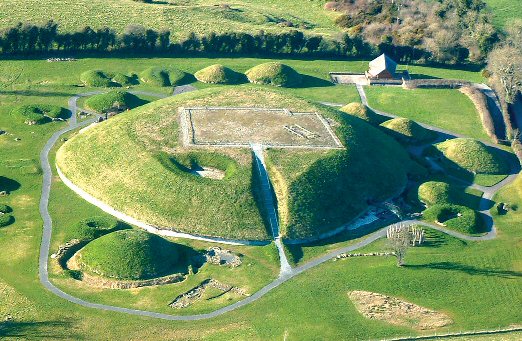
 Knowth:
(Passage Mound).
Knowth:
(Passage Mound).
This is the most heavily decorated passage mound in all Ireland, with
art on almost all of the 134 kerb-stones (now 'protected' beneath a concrete sill running
around the diameter of the mound).
The discovery of
'hidden-art' on the rear faces of the kerbstones has prompted debate
over whether this is evidence of the re-use of an existing monument as
recently determined with the Lochmariaquer menhirs in France.
(Interior schematic of knowth)
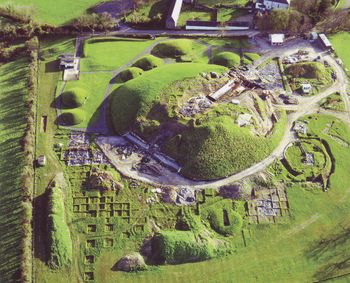
Knowth is one of the
grandest of the 300 or so passage-mounds in Ireland, and along with the other
two great mounds of
Newgrange and
Dowth, is
an imporant part of the huge megalithic observatory
that composes the Boyne Valley.
Knowth
consists of a large mound surrounded by 17 smaller ones. The oval main mound
varies in diameter from 80 to 95m (262-311ft), with a height between 12 and
15m (40-50ft).
The mound was completely 'restored' by
bulldozers and heavy machinery in the 1970's (see photo, right), giving it
the distinct look that it has today. It was found that the mound was built
up of alternating layers of turf/soil and shale/pebbles.
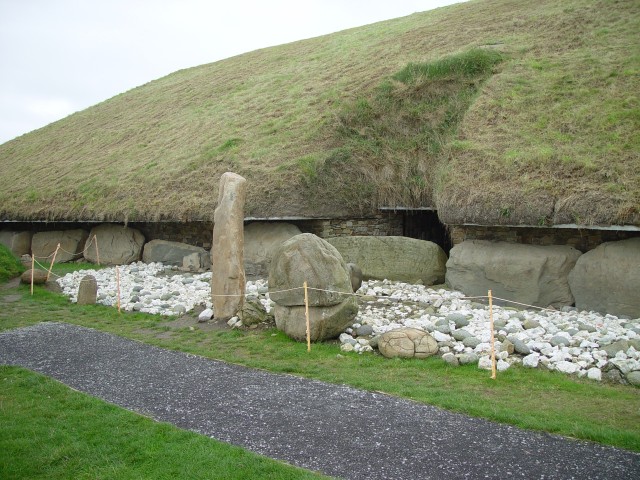 George Eogan's excavations, conducted annually since 1962, have shown
Knowth to be an exciting monument. The mound is made up of sod, clay,
stones, and shale; some of the
stones, up to 4 tons in weight, were probably quarried within a distance of
8-12km (5-8 miles). As at
Newgrange, Eogan found dark granite
cobbles brought from the Mountains of Mourne 60km to the north, and white
quartz stones from the Wicklow Mountains a similar distance south. George Eogan's excavations, conducted annually since 1962, have shown
Knowth to be an exciting monument. The mound is made up of sod, clay,
stones, and shale; some of the
stones, up to 4 tons in weight, were probably quarried within a distance of
8-12km (5-8 miles). As at
Newgrange, Eogan found dark granite
cobbles brought from the Mountains of Mourne 60km to the north, and white
quartz stones from the Wicklow Mountains a similar distance south.
The mound contains two passages, orientated
toward the east and the west respectively. The two chambers are separated by
so little that archaeologists working inside could listen to each other. George Eogan suggested that the two
passages may have been purposely orientated
toward the rising sun on 20 or 21 March and set on 22 or 23 September.
Funerary Remains at
Knowth:
Although these mounds are commonly termed
'passage-tombs' or funerary-mounds', it seems that the burials found at
Knowth are from secondary usage as it is now known that following
its construction, the hill at Knowth fell into disrepair and the mound
slipped, causing the entrances to both passages to be covered so that
the site remained practically unused for a period of two thousand years.
although it seems the site was briefly used as a burial site;
with around 35 cist graves having been found on site during excavations,
these appear to be Celtic burials. Many of the bodies found were female.
One particularly interesting grave contained the bodies of two young
men, buried head to toe,
decapitated
and buried together with a gaming set. The strong symbolism in the
layout of these funerary remains can only be guessed at. While it seems
likely that the two men in question were at odds with each other in real
life, and the gaming board placed between them is suggestive of an
intellectual dispute rather than a violent or passionate one.
We can but wonder...
During the Iron Age
Knowth again came to be used as a ritual space and a place for
burial. Knowth was enclosed by two concentric ditches and it was also
peppered with burials. Iron Age burials near the
Boyne are largely simple unmarked
graves; however the grave goods are not insignificant (Mitchell and
Ryan 2001). There are thirty-five burials at Knowth, most of which
are female. Thirty one burials are in pits and four in cists. These
burials range from the period between 190 BC and 250 AD.
Ref: (http://www.nd.edu/)
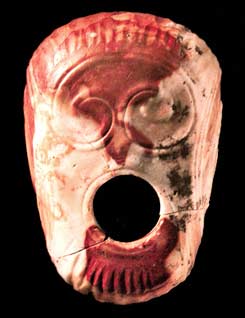
This beautiful mace-head (right), was found in the eastern passage at
Knowth. The flint itself comes from the Orkney
islands, which are by no means the nearest source of flint to the Boyne
valley. It is one of several clues that testify to a cultural exchange
between these two important megalithic complexes, along with the style of
art, exterior and interior similarities in design of the passage mounds
(i.e. Maes Howe) and a strong
astronomical theme underlying the development of the structures.
(Cultural
Connections between Boyne valley and other sites in Europe)
The Kerb-stones - This is the
most heavily decorated passage mound in all Ireland, with art on almost all
of the 134
kerb-stones, which have now been 'protected' beneath a concrete sill running
around the diameter of the mound.
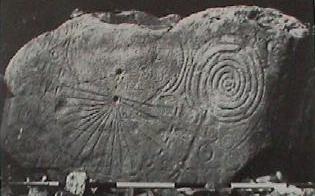
Knowth contains more than a third of
the total number of examples of megalithic art in all Western Europe.
Over 200 decorated stones were found during excavations at Knowth. Much
of the artwork is found on the kerbstones, particularly approaching the
entrances to the passages. Interestingly, much of this artwork was
carved on
backs
of the stones. There are several theories to explain this, such as that
the hidden-art was symbolic (i.e. magical), or it could
simply represent the re-cycling of existing stones. The re-use of stones
has been identified at several sites around Carnac in France, most
notably at Lochmariaquer, and from
the same time in history).
Recent research at the great Irish passage tomb of Knowth has
revealed new decorated stones, which were apparently recycled from an
earlier tomb. In this article, George Eogan describes the finds and
discusses the implication of an early phase of tomb building predating the
major passage tombs of the Boyne Valley.
(Ref:
Knowth
Before knowth)
The designs on the stones at Knowth are varied. While some
are very simple, others such as the kerb-stone K15 (see photo above), which appears to have a
semi-circular geometric shape on it, similar to a 'gnomon', or a
'protractor'. Also running down the left hand side are a series of shapes,
reminiscent of the changing shape of the moon throughout its cycle. (A
feature which is not clear at all in this photo). The same identical pattern
can be seen on the large rear supporting stone in
Le Table des Marchands
in Carnac, France. A site associated with lunar observations, and with many
other similarities to the
Boyne valley Complex.
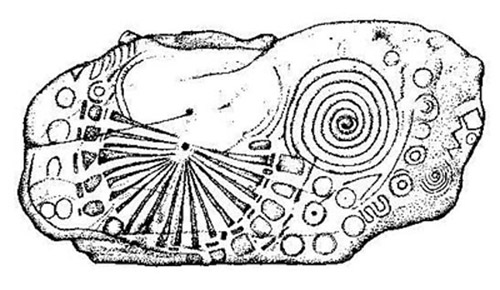
It is this set of designs (above), in particular that has
excited the most interest with regards the idea that the symbols on the
stones (many of which are repeated here and at other sites around Ireland
and Europe), may be a literal expression rather than sets of random,
abstract images.
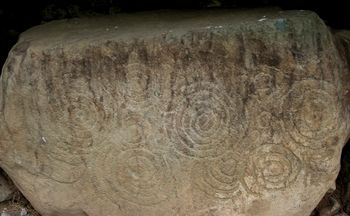

K56 (left) and K86 (right).
(Scroll down for more images of the kerb-stones).
Inside the mound - The Knowth passage mound
(Site 1) contains two passages, orientated along an east-west line. The passages
are independent of each other in the middle (they do not meet). Although it
is startling obvious from their orientation that they were designed to
capture the equinoxial sunrise and sunset, it is argued that this might not
be the case as it can no longer be proven due to the dislocation of portions
of the entrances and the presence of several large trees which currently
prevent the sun from entering today.
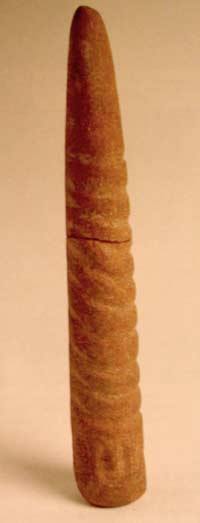 The western chamber
measures 34.2m (112ft) in length and is of the undifferentiated variety, not
absolutely straight, but with an 'elbow' about three quarters of the way,
where the passage turns slightly to the right.
The western passage ends in an
undifferentiated chamber (ie: it has no sides, it is a rectangular room).
This chamber is separated from the passage by a
sill-stone. The chamber seems to have also contained a basin stone. This
was later removed and is now located about two thirds down the passageway
where it apparently got stuck in an effort to remove it. The phallus (left),
was also found near the entrance to the western passage of the mound.
A large phallus-like stone was also recovered from an oval-shaped stone
setting not far from the entrance of
Newgrange. The western chamber
measures 34.2m (112ft) in length and is of the undifferentiated variety, not
absolutely straight, but with an 'elbow' about three quarters of the way,
where the passage turns slightly to the right.
The western passage ends in an
undifferentiated chamber (ie: it has no sides, it is a rectangular room).
This chamber is separated from the passage by a
sill-stone. The chamber seems to have also contained a basin stone. This
was later removed and is now located about two thirds down the passageway
where it apparently got stuck in an effort to remove it. The phallus (left),
was also found near the entrance to the western passage of the mound.
A large phallus-like stone was also recovered from an oval-shaped stone
setting not far from the entrance of
Newgrange.
 The eastern chamber totals 40.4m (132.5ft) in length, making it the
longest passage-tomb in Europe. Unlike the western tomb, the passage
broadens out into a cruciform chamber. Here the roof rises to a height of
5.9m (19ft) and is corbelled. The right-hand niche is the largest of the
three and contains a richly decorated stone basin. The burials were mainly
concentrated in the left-hand recess. A splendid flint mace-head decorated
with lozenge-shaped facets and superbly executed spirals was found in this
tomb. The eastern chamber totals 40.4m (132.5ft) in length, making it the
longest passage-tomb in Europe. Unlike the western tomb, the passage
broadens out into a cruciform chamber. Here the roof rises to a height of
5.9m (19ft) and is corbelled. The right-hand niche is the largest of the
three and contains a richly decorated stone basin. The burials were mainly
concentrated in the left-hand recess. A splendid flint mace-head decorated
with lozenge-shaped facets and superbly executed spirals was found in this
tomb.
The eastern passage leads to a
cruciform chamber, not unlike that to be found at Newgrange. It contains
three recesses and basin stones (right), into which the cremated remains of dead
were placed.
The right-hand recess is larger and
more elaborately decorated with megalithic art than the others, which is
typical for Irish passage graves of this type. The reason for this is
unknown.
The cruciform chamber and the large 'offering' bowls:
The cruciform shape is recognised in several prominent
passage-mounds (Newgrange,
Fourknocks,
Maes Howe), and is also seen in the
prehistoric temples on Malta. The exact origin and
purpose for this design feature can only to be guessed at. The same symbol
is repeated in the shape of the Celtic cross and the Christian cross..
The 'Offering Bowls - One of the common discoveries
inside cruciform chambers are large, shallow stone-cut bowls which are
usually placed in one of the sub-chambers.

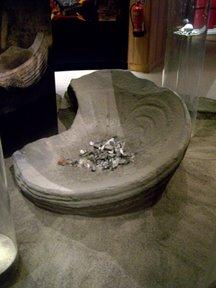
Knowth (left), Newgrange
(right).
(More about Cruciform chambers
and 'libation' bowls)
Chronology -
According to radio-carbon dating, Knowth was constructed about 500 years
before Newgrange, placing it in the middle of the fourth millennium BC.
(1)
No fewer than twelve phases can now be
distinguished, from the beginning of the Neolithic to modern times, and for
all the fame attached to the passage tombs, no less important are the later
phases. The passage tomb was succeeded by a late Neolithic Grooved Ware
phase. As well as the characteristic pottery and flints, there was also a
circular wooden structure rather like those found at Durrington Walls in
Wiltshire. Then there were spreads of Beaker domestic refuse, although apart
from pits, no structures were found. After the Beaker period, there is
little evidence for human activity for the next two thousand years and this
remains one of Knowth�s unsolved problems, especially as there is ample
evidence for Bronze and Iron Age activity in the area.
When activity resumed, it was again largely ritual: sixteen inhumation
burials in pits dating to the early centuries AD. The skeletons were
slightly crouched, although some were extended, and one was a double burial
of two adult males, both decapitated and lying head to toe. Grave goods
consisted mainly of personal ornaments, but there were bone dice and gaming
pieces. One burial was that of a little girl of about six, with a necklace
of 285 blue and amber glass beads, bone beads and bronze rings.
(2)
Archaeo-astronomy
-
Knowth passage-mound is orientated so that its two passages face east and
west, suggesting a possible equinoxial alignment. The mound is also placed,
in relation to Newgrange such that the two align with one of the moons minor
standstill's.
Apart from the kerbstone already described above (SE4),
'astronomical' art is said to exist on several other stones, in particular
stone SW22, which has been said to show the correlation between the solar
and lunar cycles. The stone has a series of 29 symbols, which range from
crescents to discs, and appear representative of the lunar cycle. It also
has a large spiral and a wavy line which is said to represent the moons
declination (over a period of two solar years, and sixty-two lunar cycles).
(1)
Knowth - Gallery of images:


Kerbstone 5 (right)
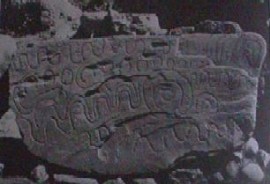 
Kerbstone K15 (right)

Kerbstone K5,
|